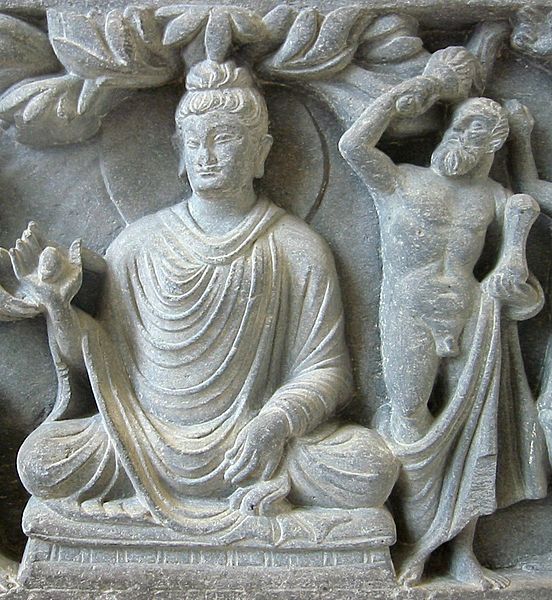Archivo: Buddha-Vajrapani-Herakles

Descripción: Panel showing the Buddha performing a miracle before ascetics. Kushan period, 2ndC-3rdC. Schist, H. 29,5 cm. (complete, here: partial view). « On the Buddha's left, Vajrapāṇi, with long, bearded face, modelled planes of musculature, genitals, a long draped overgarment from his left shoulder passing across the legs, holds a faceted vajra with rounded ends in his left hand and raises a fly-whisk like a torch in the right. » (Museum Collection on line) : This is a detail of a frieze regarding the conversion of three brothers to Buddhism. It is cropped to focus on the Buddha flanked by a figure of his guardian, Vajrapāṇi. [1]In this image, Vajrapani is depicted in a more classically Grecian style than the surrounding figures, indicative of his cross-cultural status. Vajrapani is usually syncretized with Hercules,[2] but is also sometimes syncretized with Zeus. [3] (This particular piece could be understood either way) In one hand Vajrapani carries a vajra (usually syncretized with Zeus' lightening and/or Hercules' sacred club) and in the other he brandishes a chamara, which is a fly-wisk symbolic of the sovereignty of the Buddha. [4]References ↑ "On the Buddha's left, Vajrapāṇi, with long, bearded face, modelled planes of musculature, genitals, a long draped overgarment from his left shoulder passing across the legs, holds a faceted vajra with rounded ends in his left hand and raises a fly-whisk like a torch in the right." Panel #1961,0218.1. British Museum.[1] ↑ "Heracles became Vajrapani, guardian of Sakyamuni. There is a wealth of material and studies on the subject... to explain how Heracles went from being a purely classical Greek figure to being a guardian god in the Buddhist pantheon." HSING, I-TIEN, and WILLIAM G. CROWELL. “Heracles in the East: The Diffusion and Transformation of His Image in the Arts of Central Asia, India, and Medieval China.” Asia Major, vol. 18, no. 2, 2005, pp. 103–154. JSTOR, [www.jstor.org/stable/41649907] ↑ "In the art of Gandhara Zeus became the inseparable companion of the Buddha as Vajrapani." in Freedom, Progress, and Society, by K. Satchidananda Murty p.97 ↑ The Handbook of Tibetan Buddhist Symbols p.177
Título: Buddha-Vajrapani-Herakles
Créditos: Trabajo propio
Autor(a): User:World Imaging
Términos de Uso: Creative Commons Attribution-Share Alike 3.0
Licencia: CC BY-SA 3.0
Enlace de Licencia: http://creativecommons.org/licenses/by-sa/3.0/
¿Se exige la atribución?: Sí
Usos del archivo
La siguiente página enlaza a este archivo:

